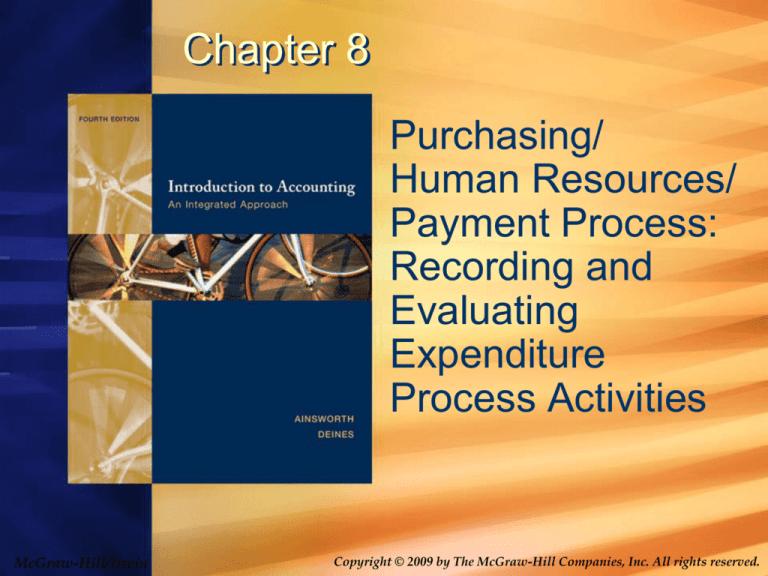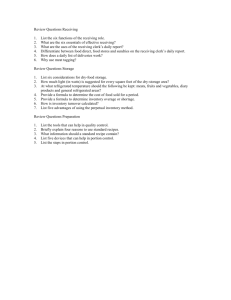
Chapter 8
Purchasing/
Human Resources/
Payment Process:
Recording and
Evaluating
Expenditure
Process Activities
McGraw-Hill/Irwin
Copyright © 2009 by The McGraw-Hill Companies, Inc. All rights reserved.
What is the Difference between Merchandising
and Manufacturing Inventories?
• Merchandising
Inventory purchased to be resold
Merchandise Inventory account
• Manufacturing
Inventory purchased to be used to make
products
Raw Materials Inventory account
8-2
What is the Difference between Periodic
and Perpetual Inventory Systems?
• Periodic
Determine ending inventory and cost of goods
sold at the end of the period
• Perpetual
Determine cost of goods sold and ending
inventory on a continuous basis
8-3
How are Inventory Activities Recorded in
a Periodic System?
• Purchase
Debit Purchases
Credit Accounts Payable
• Return or allowance
Debit Accounts Payable
Credit Purchase Returns and Allowances
• Freight or insurance on purchases
Debit Freight-in (Insurance-in)
Credit Accounts Payable (Cash)
8-4
How are Inventory Activities Recorded in
a Perpetual System?
• Purchase
Debit Inventory
Credit Accounts Payable
• Return or allowance
Debit Accounts Payable
Credit Inventory
• Freight or insurance on purchases
Debit Inventory
Credit Accounts Payable (Cash)
8-5
What is the Difference between the Net
Price and Gross Price Methods?
• Net price
Purchases and purchase returns/allowances
are recorded net of the available discount
Discounts lost are recorded separately
• Gross price
Purchases and purchase returns/allowances
are recorded at the gross price
Discounts taken are recorded separately
8-6
Example
• A company purchases $1,000 (gross) of
inventory (terms: 2/10, n/30), subsequently
returns $200 (gross) of the inventory, and
pays for the inventory within the discount
period.
8-7
Net Price Method/Perpetual
• Purchase
Increase (debit) inventory by $980 ($1,000 * 0.98)
Increase (credit) accounts payable by $980
• Return
Decrease (debit) accounts payable by $196 ($200 *
0.98)
Decrease (credit) inventory by $196
• Payment within discount period
Decrease (debit) accounts payable by $784 ($980 - $196)
Decrease (credit) cash by $784
8-8
Gross Price/Perpetual
• Purchase
Increase (debit) inventory by $1,000
Increase (credit) accounts payable by $1,000
• Return
Decrease (debit) accounts payable by $200
Decrease (credit) inventory by $200
• Payment within discount period
Decrease (debit) accounts payable by $800 ($1,000 - $200)
Decrease (credit) cash by $784 ($800 * 0.98)
Recognize discount taken (credit inventory) for $16
8-9
What is the Balance in Inventory
under Each Pricing Method?
• Net price
Inventory = $980 - $196 = $784
• Gross price
Inventory = $1,000 - $200 - $16 = $784
8-10
What if the Payment is Made After the
Discount Period has Expired?
• Net price
Decrease (debit) accounts payable by $784 ($980 - $196)
Recognize discount lost (debit Discounts Lost) for $16
Decrease (credit) cash by $800 ($784/0.98)
• Gross price
Decrease (debit) accounts payable by $800 ($1,000 - $200)
Decrease (credit) cash by $800
8-11
Now What is the Balance of Inventory
under Each Pricing Method?
• Net price
Inventory = $980 - $196 = $784
• Gross price
Inventory = $1,000 - $200 = $800
• Does this mean that the inventory under the gross
price method is worth more?
No, it simply reflects management’s beliefs concerning
discounts.
• Gross = cost reduction when taken
• Net = financing cost when lost
8-12
What is the Basic Flow of Information in
the Payroll Process?
• Employees record time worked on time cards and
factory records time worked on time tickets
• Timekeeping compares time cards and time
tickets
• Payroll records time worked, deductions, etc.
• Accounts payable approves payroll and notifies
cashier
• Cashier pays employees
8-13
What is the Difference between Gross Pay and Net
Pay from the Employer’s Point of View?
• Gross pay—salary and wage expense
(amount incurred in an attempt to generate
revenue)
• Net pay—cash outflow to employees
• Withholdings—liabilities to pay the entity to
which the funds belong
8-14
What is the Difference between Salary/Wage
Expense and Payroll Tax Expense?
• Salary/wage expense—expense incurred
from using employees in an attempt to
generate revenue
• Payroll tax expense—expense incurred due
to having employees (matching FICA and
unemployment taxes)
8-15
When are Expenses Recognized?
• When incurred, regardless of when cash is paid.
Assume December 31 year for examples that
follow.
Example #1—receive a utility bill in December, pay the
bill in January, expense is recognized in December
Example #2—pay insurance for 6 months in November,
recognize 2 months of insurance expense in December
Example #3—pay the local newspaper in December for
an ad to be run in December, recognize expense in
December
8-16
Inventory Example
• Inventory is an asset when purchased
• When inventory is sold, we recognize the
expense, called Cost of Goods Sold
8-17
How are Expenditure Process Activities
Communicated to Users?
• Income statement
Discounts lost, Loss on Inventory, other
expenses
Cost of goods sold
• Balance sheet
Ending balance of inventory, other assets, and
liabilities
• Statement of cash flows
8-18
Cash paid for inventory and other expenditure
process items
How can we Estimate the Cash Paid for
Inventory?
• Beginning inventory (balance sheet)
• + Net purchases (calculated)
• = Maximum inventory available
• Cost of goods sold (income statement)
• = Ending inventory (balance sheet)
• Then,
8-19
Estimating Cash Paid for Inventory,
Continued
• Beginning accounts payable (balance sheet)
• + Net purchases (from inventory account)
• = Maximum amount owed to suppliers
• Cash paid for inventory (calculated)
• = Ending accounts payable (balance sheet)
8-20






